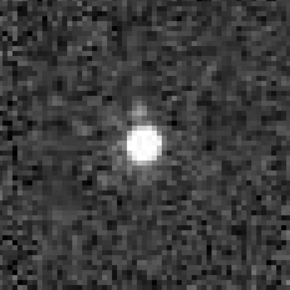
Back 225088 Gonggong Afrikaans غونغون (كوكب قزم) Arabic (225088) Gonggong Catalan Gonggong (plutoid) Czech Кункун CV (225088) Gonggong German 225088 Γκόνγκονγκ Greek 225088 Gongono Esperanto (225088) Gonggong Spanish گونگگونگ Persian
 Low-resolution Hubble Space Telescope image of Gonggong and its moon Xiangliu, September 2010 | |
| Discovery[1][2] | |
|---|---|
| Discovered by | |
| Discovery site | Palomar Obs. |
| Discovery date | 17 July 2007 |
| Designations | |
| (225088) Gonggong | |
| Pronunciation | /ˈɡɒŋɡɒŋ/ |
Named after | Gonggong |
| 2007 OR10 | |
| TNO[3] · SDO[4] 3:10 res.[5][6] · dwarf planet[7] | |
| Symbol | |
| Orbital characteristics[1] | |
| Epoch 17 December 2020 (JD 2459200.5) | |
| Uncertainty parameter 3 | |
| Observation arc | 37 years and 90 days (13604 days) |
| Earliest precovery date | 19 August 1985 |
| Aphelion | 101.190 AU (15.1378 Tm) |
| Perihelion | 33.781 AU (5.0536 Tm) |
| 67.485 AU (10.0956 Tm) | |
| Eccentricity | 0.49943 |
| 554.37 yr (202,484 days)[3] | |
| 106.496° | |
| 0° 0m 6.401s / day | |
| Inclination | 30.6273° |
| 336.8573° | |
| 17 February 1857[8] | |
| 207.6675° | |
| Known satellites | 1 (Xiangliu) |
| Physical characteristics | |
| 1230±50 km[9] | |
| 615±25 km | |
| Flattening | 0.03 (for a rotation period of 22.4 h)[9] 0.007 (for a rotation period of 44.81 h)[9] |
| Mass | (1.75±0.07)×1021 kg[9] |
Mean density | 1.74±0.16 g/cm3[9] |
Equatorial surface gravity | ≈ 0.18 m/s2 |
Equatorial escape velocity | ≈ 0.62 km/s |
| 22.40±0.18 h or 44.81±0.37 h (ambiguous,[10][11] but 22.4 h more likely[9]) | |
| 0.14±0.01[9] | |
| B−V=1.38±0.03[12][13] V−R=0.86±0.02[12][13] V−I=1.65±0.028[12][13] | |
| 21.4[14] | |
| 2.34[10] · 2.0[7] 1.8[3] · 1.6 (assumed)[1] | |
Gonggong (minor-planet designation: 225088 Gonggong) is a dwarf planet and a member of the scattered disc beyond Neptune. It has a highly eccentric and inclined orbit during which it ranges from 34–101 astronomical units (5.1–15.1 billion kilometers; 3.2–9.4 billion miles) from the Sun. As of 2019[update], its distance from the Sun is 88 AU (13.2×109 km; 8.2×109 mi), and it is the sixth-farthest known Solar System object. According to the Deep Ecliptic Survey, Gonggong is in a 3:10 orbital resonance with Neptune, in which it completes three orbits around the Sun for every ten orbits completed by Neptune. Gonggong was discovered in July 2007 by American astronomers Megan Schwamb, Michael Brown, and David Rabinowitz at the Palomar Observatory, and the discovery was announced in January 2009.
At approximately 1,230 km (760 mi) in diameter, Gonggong is similar in size to Pluto's moon Charon, making it the fifth-largest known trans-Neptunian object (apart possibly from Charon). It may be sufficiently massive to be in hydrostatic equilibrium and therefore a dwarf planet. Gonggong's large mass makes retention of a tenuous atmosphere of methane just possible, though such an atmosphere would slowly escape into space. The object is named after Gònggōng, a Chinese water god responsible for chaos, floods and the tilt of the Earth. The name was chosen by its discoverers in 2019, when they hosted an online poll for the general public to help choose a name for the object, and the name Gonggong won.
Gonggong is red, likely due to the presence of organic compounds called tholins on its surface. Water ice is also present on its surface, which hints at a brief period of cryovolcanic activity in the distant past. With a rotation period of around 22 hours, Gonggong rotates slowly compared to other trans-Neptunian objects, which typically have periods of less than 12 hours. The slow rotation of Gonggong may have been caused by tidal forces from its natural satellite, named Xiangliu.
- ^ a b c Cite error: The named reference
MPC-objectwas invoked but never defined (see the help page). - ^ Cite error: The named reference
MPECwas invoked but never defined (see the help page). - ^ a b c Cite error: The named reference
jpldatawas invoked but never defined (see the help page). - ^ Cite error: The named reference
MPC-CEN-SDO-listwas invoked but never defined (see the help page). - ^ Cite error: The named reference
Buiewas invoked but never defined (see the help page). - ^ Cite error: The named reference
johnstonsarchive-TNO-listwas invoked but never defined (see the help page). - ^ a b Cite error: The named reference
Brown-dplistwas invoked but never defined (see the help page). - ^ Cite error: The named reference
Horizons1857was invoked but never defined (see the help page). - ^ a b c d e f g Cite error: The named reference
massdensitywas invoked but never defined (see the help page). - ^ a b Cite error: The named reference
Pal-2016was invoked but never defined (see the help page). - ^ Cite error: The named reference
scida2015was invoked but never defined (see the help page). - ^ a b c Cite error: The named reference
Boehnhardt-2014was invoked but never defined (see the help page). - ^ a b c Cite error: The named reference
lcdbwas invoked but never defined (see the help page). - ^ Cite error: The named reference
Grundy-orbitswas invoked but never defined (see the help page).